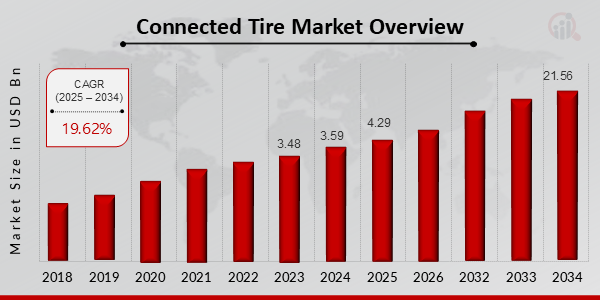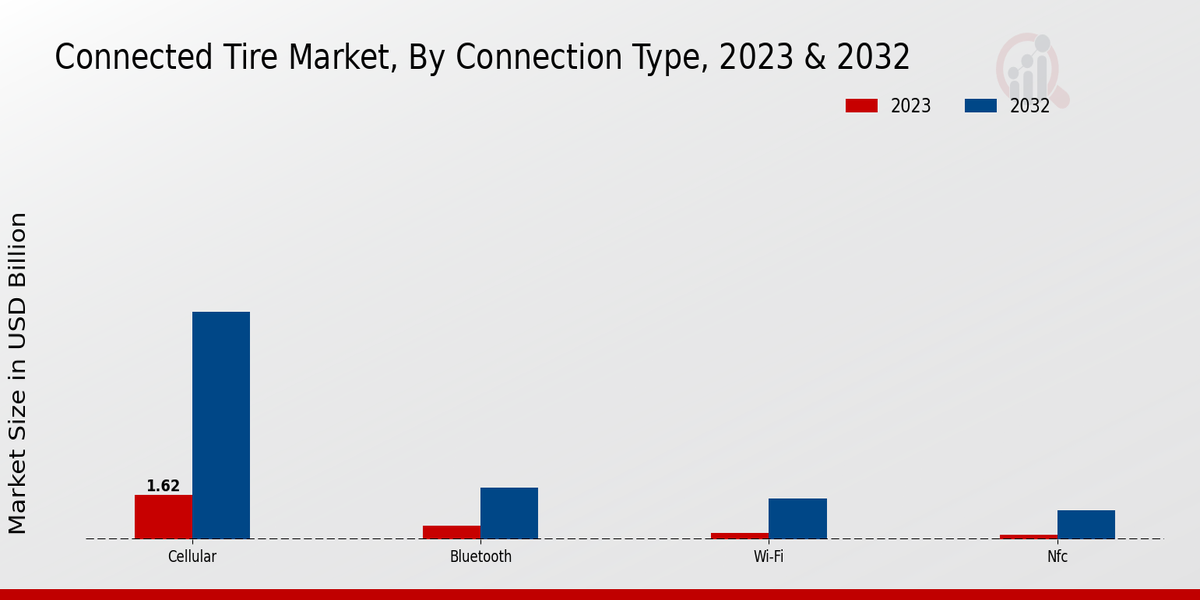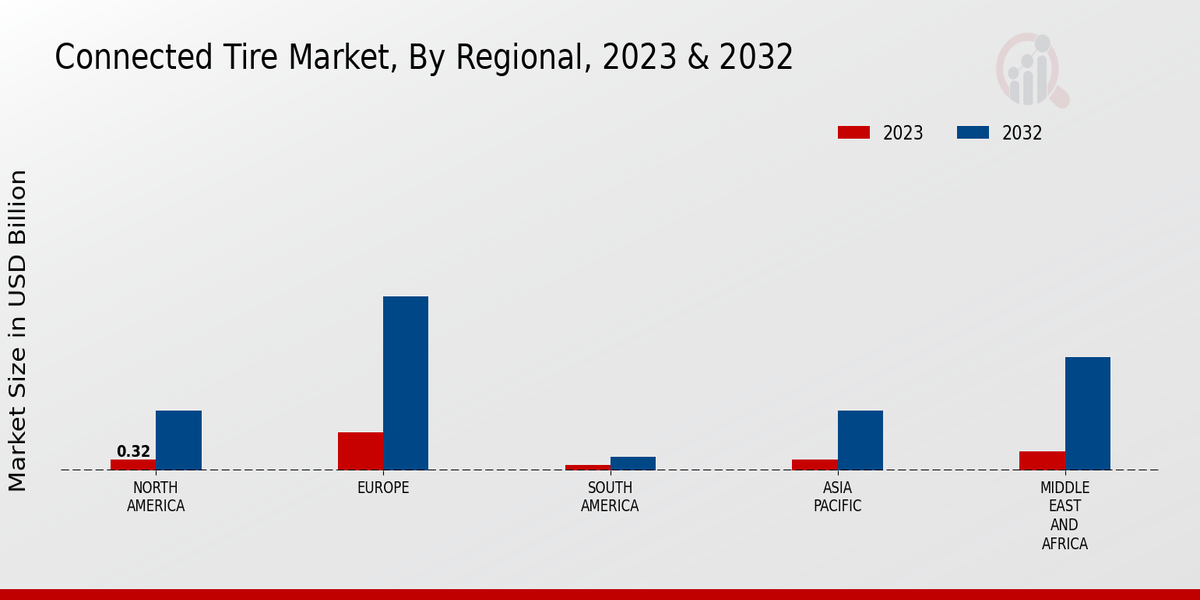Connected Tire Market Overview
Connected Tire Market is projected to grow from USD 4.29 Billion in 2025 to USD 21.56 Billion by 2034, exhibiting a compound annual growth rate (CAGR) of 19.62% during the forecast period (2025 - 2034). Additionally, the market size for Connected Tire Market was valued at USD 3.59 billion in 2024.
Key Connected Tire Market Trends Highlighted
The market for linked tires has a lot of room to develop, thanks to advancements in autonomous driving and electric car technology. The need for sophisticated tire monitoring systems from these cutting-edge cars makes connected tires an appealing option. Furthermore, government laws and growing safety concerns are encouraging the use of connected tires. By giving drivers access to real-time information on critical factors like temperature, tread depth, and tire pressure, these systems empower drivers to take preventative measures against possible threats.
Furthermore, the combination of connected tires and car telematics systems improves driving enjoyment, fuel economy, and vehicle performance. Modern connected tire trends center on the use of sophisticated sensors, data analytics systems, and communication protocols. These developments provide more accurate monitoring and predictive maintenance capabilities by facilitating smooth data transmission between tires and automobiles.
Future car safety and efficiency are anticipated to be significantly shaped by connected tires as technology advances.
Figure 1: Connected Tire Market Size, 2025-2034 (USD Billion)

Source: Primary Research, Secondary Research, MRFR Database and Analyst Review
Connected Tire Market Drivers
Rising Demand for Enhanced Vehicle Safety and Efficiency
A clear motivator of the Connected Tire Market is the increased demand for vehicle safety and efficiency. These tools provide real-time data in regard to tire temperature, pressure, tread level, and other factors, which can help the driver detect an anomaly before it becomes serious. This way, it may be possible to avoid accidents, lost time, and decreased fuel economy. Furthermore, these tools may be combined with other systems in a vehicle such as ABS or ESC.
The high levels of motive power could also make the earlier warming of an issue through a different system more valuable. Due to the combination of these features, the tool is likely to become a common feature for consumers and vehicle manufacturers.
Increasing Adoption of Advanced Driver Assistance Systems (ADAS)
The increasing adoption of Advanced Driver Assistance Systems (ADAS) is another major driver of the Connected Tire Market.
ADAS features such as lane departure warning, automatic emergency braking, and adaptive cruise control rely on real-time data from sensors throughout the vehicle, including the tires. Connected tires can provide this data more accurately and reliably than traditional tire sensors, which can help improve the performance of ADAS features. As ADAS features become more common, the demand for connected tires is also expected to grow.
Government Regulations and Industry Standards
Government regulations and industry standards are also playing a role in driving the growth of the Connected Tire Market. In some countries, such as the European Union, it is already mandatory for new vehicles to be equipped with tire pressure monitoring systems (TPMS).
TPMS can be integrated with connected tires to provide more comprehensive data on tire performance. In addition, industry standards such as the ISO 22442-1:2019 standard for connected tires are helping to ensure that connected tires are interoperable and meet safety and performance requirements.
Connected Tire Market Segment Insights
Connected Tire Market Connection Type Insights
The Connected Tire Market is segmented based on connection type into cellular, Bluetooth, Wi-Fi, and NFC. Among these, the cellular segment held the largest market share in 2023 and is expected to continue its dominance throughout the forecast period. The growth of this segment can be attributed to the increasing adoption of cellular-based connectivity solutions by tire manufacturers. Cellular connectivity allows tires to communicate with other devices and systems, such as vehicle telematics systems and cloud-based platforms.
This enables real-time monitoring of tire pressure, temperature, and other vital parameters, which helps improve vehicle safety and performance. The Bluetooth segment is expected to witness significant growth during the forecast period. Bluetooth technology offers short-range wireless connectivity and is widely used in automotive applications, including tire pressure monitoring systems (TPMS). The growing popularity of Bluetooth-enabled TPMS is driving the growth of the Bluetooth segment. The Wi-Fi segment is expected to grow at a steady pace during the forecast period.
Wi-Fi connectivity allows tires to connect to local Wi-Fi networks, enabling data transfer and remote monitoring. The increasing adoption of Wi-Fi-based tire monitoring systems is expected to drive the growth of this segment. The NFC segment is expected to witness moderate growth during the forecast period. NFC technology allows for short-range wireless communication between devices and is used in various applications, including tire identification and tracking. The growing adoption of NFC-based tire tracking solutions is expected to drive the growth of this segment.
Overall, the Connected Tire Market is expected to grow significantly during the forecast period, driven by the increasing demand for connected tire solutions from various end-use industries. The market growth is expected to be supported by the rising adoption of cellular-based connectivity solutions, the growing popularity of Bluetooth-enabled TPMS, and the increasing use of Wi-Fi-based tire monitoring systems.

Source: Primary Research, Secondary Research, MRFR Database and Analyst Review
Connected Tire Market Application Insights
The Connected Tire Market is segmented by Application into Tire Pressure Monitoring, Tire Temperature Monitoring, Tread Depth Monitoring, and Vehicle Health Monitoring. The Tire Pressure Monitoring segment held a significant market share in 2023 and is estimated to dominate the market over the forecast period. The Tire Temperature Monitoring segment is estimated to be valued at USD 1.2 billion in 2023, and it is expected to grow at 18.5% CAGR from 2024 to 2032. The Tread Depth Monitoring segment is expected to grow at 19.2% CAGR from 2024 to 2032, reaching a value of USD 2.5 billion by 2032.
The Vehicle Health Monitoring segment is estimated to grow at 19.8% CAGR from 2024 to 2032, reaching a value of USD 3.2 billion by 2032. The growth of the connected tire market is primarily attributed to the rising demand for enhanced safety and efficiency within the transportation industry.
Connected Tire Market Vehicle Type Insights
The Connected Tire Market is segmented by Vehicle Type into Passenger Cars, Commercial Vehicles, and Two-Wheelers. Among these segments, Passenger Cars held the largest market share in 2023, accounting for over 55% of the global revenue. The dominance of Passenger Cars in this segment can be attributed to the increasing adoption of advanced driver assistance systems (ADAS) and autonomous driving technologies in passenger vehicles.
Additionally, rising consumer awareness about safety and convenience features is driving the demand for connected tires in passenger cars. Commercial Vehicles are expected to witness significant growth in the coming years due to the increasing adoption of telematics and fleet management systems.
The integration of connected tires with fleet management systems allows fleet operators to monitor tire pressure, tread depth, and other vital parameters remotely, leading to improved fleet efficiency and reduced operating costs. Two-wheelers are also gaining traction in the connected tire market, particularly in emerging economies. The growing popularity of electric scooters and motorcycles is driving the demand for connected tires that can provide real-time data on tire pressure, battery status, and other metrics. As per Connected Tire Market data, the Two-Wheelers segment is projected to exhibit a CAGR of over 20% during the forecast period 2024-2032.
Connected Tire Market Sensor Type Insights
The Connected Tire Market is segmented by Sensor Type into Internal Sensors and External Sensors. Internal Sensors are embedded within the tire and measure tire pressure, temperature, and tread depth. External Sensors are attached to the tire's exterior and measure the same parameters as Internal Sensors, as well as additional data such as tire wear and road conditions. The Internal Sensors segment is expected to hold a larger market share in 2023 due to their lower cost and easier installation compared to External Sensors.
However, the External Sensors segment is projected to grow at a faster CAGR during the forecast period, owing to their ability to provide more comprehensive data and their increasing adoption in commercial vehicles. In 2023, the Internal Sensors segment is expected to account for approximately 60% of the Connected Tire Market revenue, while the External Sensors segment is expected to account for the remaining 40%.
By 2032, the External Sensors segment is projected to grow to account for over 50% of the market revenue, driven by the increasing demand for advanced tire monitoring systems in commercial vehicles and the growing adoption of autonomous vehicles.
Connected Tire Market Regional Insights
The regional segmentation of the Connected Tire Market offers insights into the market's geographic distribution and growth potential. North America is anticipated to hold a significant market share, driven by factors such as technological advancements, increasing adoption of connected vehicles, and government initiatives promoting smart transportation. Europe follows closely, with a growing demand for connected tires from the automotive industry and a focus on improving road safety. The Asia-Pacific region is projected to witness substantial growth, fueled by the rising production and sales of automobiles, particularly in countries like China and India.
South America and the Middle East and Africa (MEA) regions are expected to experience moderate growth, with increasing investments in infrastructure and the adoption of connected technologies in the transportation sector. Overall, the regional segmentation highlights the varying market dynamics and opportunities across different geographies, enabling stakeholders to tailor their strategies accordingly.

Source: Primary Research, Secondary Research, MRFR Database and Analyst Review
Connected Tire Market Key Players and Competitive Insights
Major players in the Connected Tire Market are focusing on developing innovative technologies to enhance the performance and capabilities of connected tires. Leading Connected Tire Market players are investing heavily in research and development to stay ahead of the competition and meet the evolving needs of customers. The Connected Tire Market development is driven by the increasing demand for safety and convenience features in vehicles. The competitive landscape of the Connected Tire Market is characterized by the presence of a few dominant players and several smaller players.
Michelin, a leading player in the Connected Tire Market, offers a range of connected tire solutions that provide real-time tire data to drivers and fleet managers. The company's connected tire technology allows drivers to monitor tire pressure, temperature, and tread depth, helping them to improve safety and extend tire life. Michelin is also working on developing new connected tire technologies that will enable predictive maintenance and other advanced features.
Continental, a major player in the Connected Tire Market, provides a comprehensive suite of connected tire solutions for passenger vehicles, commercial vehicles, and off-highway vehicles. The company's connected tire technology offers a variety of features, including real-time tire data monitoring, predictive maintenance, and remote tire management. Continental is also investing in the development of new connected tire technologies that will enhance safety, efficiency, and convenience.
Key Companies in the Connected Tire Market Include
- Hankook Tire
- Bridgestone
- Goodyear
- Sumitomo Rubber Industries
- Triangle Tyre
- Toyo Tire Rubber
- Giti Tire
- Continental
- Jinyu Tire Rubber
- Michelin
- Apollo Tyres
- Kumho Tire
- Pirelli
- Nexen Tire
- Yokohama Rubber
Connected Tire Market Developments
The increasing demand for enhanced safety and convenience, growing adoption of connected vehicles, and government initiatives to promote smart transportation are driving market growth.
Key industry participants include Continental AG, Michelin, Pirelli C. S.p.A., and The Goodyear Tire Rubber Company.
Recent developments include the launch of Continental's ContiConnect 2.0 platform, which provides real-time tire data and predictive maintenance capabilities, and Michelin's acquisition of StackPointCloud, a provider of cloud-based data management solutions for the automotive industry.
Connected Tire Market Segmentation Insights
-
Connected Tire Market Connection Type Outlook
- Cellular
- Bluetooth
- Wi-Fi
- NFC
-
Connected Tire Market Application Outlook
- Tire Pressure Monitoring
- Tire Temperature Monitoring
- Tread Depth Monitoring
- Vehicle Health Monitoring
-
Connected Tire Market Vehicle Type Outlook
- Passenger Cars
- Commercial Vehicles
- Two-Wheelers
-
Connected Tire Market Sensor Type Outlook
- Internal Sensors
- External Sensors
-
Connected Tire Market Regional Outlook
- North America
- Europe
- South America
- Asia Pacific
- Middle East and Africa
| Report Attribute/Metric |
Details |
|
Market Size 2024
|
3.59 (USD Billion)
|
|
Market Size 2025
|
4.29 (USD Billion)
|
|
Market Size 2034
|
21.56 (USD Billion)
|
|
Compound Annual Growth Rate (CAGR)
|
19.62% (2025 - 2034)
|
|
Report Coverage
|
Revenue Forecast, Competitive Landscape, Growth Factors, and Trends
|
|
Base Year
|
2024
|
|
Market Forecast Period
|
2025 - 2034
|
|
Historical Data
|
2019 - 2023
|
|
Market Forecast Units
|
USD Billion
|
| Key Companies Profiled |
Hankook Tire, Bridgestone, Goodyear, Sumitomo Rubber Industries, Triangle Tyre, Toyo Tire Rubber, Giti Tire, Continental, Jinyu Tire Rubber, Michelin, Apollo Tyres, Kumho Tire, Pirelli, Nexen Tire, Yokohama Rubber |
| Segments Covered |
Connection Type, Application, Vehicle Type, Sensor Type, Regional |
| Key Market Opportunities |
Realtime tire monitoring Tire performance optimization Enhanced vehicle safety Predictive tire maintenance Reduced downtimes and costs |
| Key Market Dynamics |
Rising Adoption of Advanced Driver Assistance Systems (ADAS) Increasing Awareness of Vehicle Safety Growing Demand for Fleet Management Integration with Telematics and IoT Platforms Government Regulations on Vehicle Safety |
| Countries Covered |
North America, Europe, APAC, South America, MEA |
Frequently Asked Questions (FAQ) :
The Connected Tire Market is expected to reach a valuation of USD 21.56 billion by 2034, exhibiting a CAGR of 19.62% during the forecast period (2025-2034).
The Asia-Pacific region is anticipated to dominate the Connected Tire Market due to the increasing adoption of connected technologies in the automotive industry and government initiatives promoting smart transportation.
Connected Tires find applications in passenger cars, commercial vehicles, and off-highway vehicles. The growing demand for enhanced safety, fuel efficiency, and vehicle performance is fueling the adoption of Connected Tires.
Major players in the Connected Tire Market include Continental AG, Michelin, Goodyear Tire Rubber Company, Bridgestone Corporation, and Pirelli C. S.p.A. These companies are investing in research and development to enhance their product offerings and expand their market presence.
The rising demand for connected vehicles, advancements in sensor technology, increasing government regulations for vehicle safety, and growing consumer awareness about the benefits of Connected Tires are key factors driving the market growth.
The Connected Tire Market is anticipated to witness significant growth in the coming years due to the integration of advanced technologies such as artificial intelligence (AI), machine learning (ML), and the Internet of Things (IoT) into Connected Tires.
Challenges faced by the Connected Tire Market include data security and privacy concerns, technical complexities in integrating Connected Tires with vehicle systems, and the high cost of implementation and maintenance.
The COVID-19 pandemic had a moderate impact on the Connected Tire Market. However, with the easing of travel restrictions and the recovery of the automotive industry, the market is expected to regain its growth momentum.
Key trends shaping the Connected Tire Market include the increasing adoption of electric vehicles, the development of self-driving cars, and the growing focus on sustainability. These trends are creating new opportunities for Connected Tire manufacturers.
The future outlook for the Connected Tire Market is positive. The rising demand for connected vehicles, technological advancements, and government initiatives are expected to drive the market growth in the coming years.

















